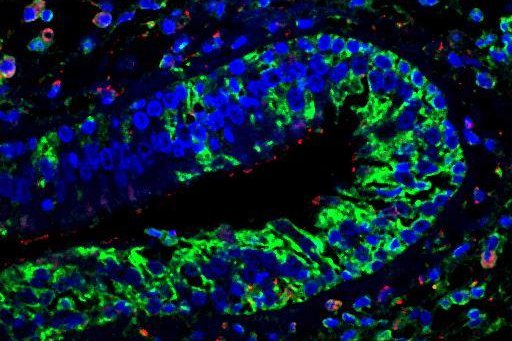Immunohistochemical staining of nasal polyp tissue by researches in Germany shows components of the leukotriene cascade are active in epithelial cells and infiltrating inflammatory cells, which suggests a different path for treatment than the one steroid drugs appear to be useless against. Photo by Helmholtz Zentrum München
NEUHERBERG, Germany, Aug. 26 (UPI) -- While people at any age can develop some allergies, researchers found the age an allergy emerges may determine the efficacy of treatments to control it.
Adults exposed to home dust mites who develop allergies may be resistant to corticosteroids used to treat the condition, researchers in Germany found in a recent study, published in The Journal of Allergy and Clinical Immunology.
In asthma and related inflammatory conditions, which affect more than 300 million people around the world, a cascade of effects changes the structure of airways.
Researchers at Helmholtz Zentrum München and the Technical University of Munich were curious to find why steroid treatments may not work with some adults who develop allergies to common dust mites found in homes. They found the way mites affect the airway remodeling in adults should be considered when selecting treatment for allergies, based on messenger substances in the body called leukotrienes.
"It is striking that leukotrienes appear to play an important role, especially when adults acquire an allergy," Katharina Dietz, a researcher at the German Center for Lung Research and lead author of the study, said in a press release. "They are part of a whole cascade of signals ultimately leading to a response to the house dust mite extract."
During the study, the researchers found extracts from dust mites elicited different responses in the lungs of mice predisposed to allergies.
Depending on age of exposure to the extracts, differences in the way a signaling protein, Wnt5a, and the enzymes transglutaminase 2 and phospholipase A2 react, in addition to leukotrienes, causes allergies in adults to be more difficult to treat.
The researchers say, however, that identifying the cascade of action leading to allergies suggests a treatment target in patients whose condition does not respond to steroid treatments.
"This cascade cannot be stopped through treatment with cortisone, the standard treatment for allergy," said Dr. Julie Esser-von Bieren, a researcher at the Center for Allergy and Environment at the Technical University of Munich. "The strong presence of the leukotriene cascade in the inflamed airway epithelium refutes the common assumption that structural cells can be neglected as leukotriene producers. On the contrary: In a chronic, cortisone-resistant inflammation in the form of asthma or nasal polyps, the use of drugs targeting the epithelial leukotriene cascade should be considered, depending on the age and allergy status of the patients."















